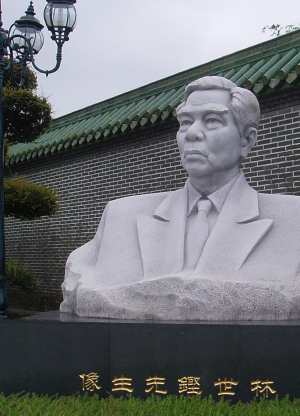Wed, 31 May
And so we bid farewell to historic Shantou and set off on our journey back to Hong Kong. But not before visiting one last attraction – possibly the weirdest of the trip.
As our driver expertly lurches between potholes, inter-city buses and over-laden trucks, it occurs to me that, despite being in a state of constant repair like many main roads in the Western world, the Shen Shan Expressway is unusual. There is zero roadkill to be seen – something I will ask my companions about over lunch. There are banners warning of the death penalty for highway robbery. There are toll booths in the least expected places, manned by toothsome young women who raise their left hand, palm outwards, as each vehicle pulls away. And there are frequent signs saying ‘Next Exit 30km’ or more, meaning that it provides no access to dozens of sizeable communities in its path through this well-populated region.
The effects of this seem evident when we pull off somewhere in Shanwei and have to double back around 10 miles, through increasingly ramshackle and lifeless towns. After some twists and turns, and another set of tollbooths for a stretch of modern road leading from nowhere to nowhere, we end up on a muddy lane going through a village with old but reasonably neat piles of rotting garbage on the sidewalk and plaster peeling off the mouldy buildings. At the end of the lane is a new, very long, tall, beautifully whitewashed wall. We stop outside ornate gates, which a man opens for us. We drive into a courtyard and alight, while another man opens an equally grandiose set of interior gates. We stroll into a massive square, with a fountain, a garden to one side, various statues, ornamental pillars and a large building in the far corner. Is the initial impression of Tiananmen intentional?

Apart from a few caretakers and gardeners, we are alone here. This is a freshly built monument to the glory of one Lam Sai-kam (various transliterations are possible). I think I know my tycoons, but I fail to pin this one down. Something to do with garments, says Boris, before adding, “probably money laundering.” This place would be a mausoleum, but for the fact that, apparently, Mr Lam is very much alive. At one end of the main parade-ground expanse is a statue of the great man, and a series of friezes showing his and his wife’s works, helping the young and old, leading, inspiring and building the community. Kim Jong-il would drool.
The house is a series of courtyards, linking open-walled chambers over-decorated with carvings, statues, plants and fancy ceilings. Lam apparently intends this as an example of what Southern Chinese homes used to be like – before they somehow turned into the crumbling and cracked, soot-stained slums invisible just yards away behind the towering walls. A smaller square to one side is lined by 300 or so marble panels featuring poems and pictures offered by shoe-shiners from Guangdong, Hong Kong, Macau, Beijing, other provinces and, of course, Thailand. It is hard to believe that this is the creation of a happy man. The place warrants a separate page of photos.

